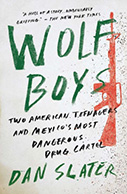WOLF BOYS: TWO AMERICAN TEENAGERS AND MEXICO’S MOST DANGEROUS DRUG CARTEL

Author: Dan Slater
Publisher: New York: Simon & Schuster, 2016. 368p.
Reviewer: Rashi K. Shukla | October 2017
In Wolf Boys, Dan Slater provides readers with an in-depth understanding of the historical, social, and political processes by which Mexican drug cartel activities became integrated into the United States (U.S.). Through a focus on the border cities of Laredo, Texas and Nuevo Laredo, Mexico, the pathways by which U.S. law enforcement officials would eventually come face-to-face with U.S. citizens engaged in drug cartel activities on both sides of the U.S.-Mexico border are documented. The book is based on a number of sources, including trial testimony, interviews, law enforcement reports, letters, and according to the author, relies heavily on other works when it comes to information about history and context. The book is comprised of five parts, an Epilogue, and a review of sources.
Part I, The Straight Hard Workers, provides background information on key players and the geopolitical history of the two main cities. Extensive details on the political and social environments that frame the story of the Wolf Boys is provided. The backstory of Robert Garcia, one of the main law enforcement officials, his movement to the cartel-free city of Laredo, his subsequent stint with the Drug Enforcement Administration, and eventual return to Laredo, are described. Interstate-35 is described as one of the key smuggling routes in the U.S. The narrative then shifts to Gabriel Cardona, a young American with the rare potential for success amongst his associates, and the events and decisions that would alter his life trajectory and eventually lead him into a life of crime. Significant historical events, including the September 11th terrorist attacks, are integrated into a discussion about the futile drug war which, from a historical perspective, is presented as one that has been failing for more than 200 years. Commentary on the history of Laredo and the role of pharmaceutical drugs are intertwined into storylines about Gabriel and his compadre Bart Reta. They are two American boys who evolve from smalltime smuggling into joining the ranks of a Mexican cartel.
Part II, The Company, describes the development of Laredo, beginning with the American victory in the Mexican-American War and the expansion of manifest destiny. A description of the role played by the pharmaceutical industry at the time of the Civil War, and subsequent calls for the regulation and prohibition of drugs, sets the stage for the lucrative black market that emerges. Political decisions on both sides of the border are shown to influence the development of the narco-state that would come to exist in the form that it does today. The historical narrative moves back and forth between events occurring within the U.S. and those occurring in Mexico, to demonstrate the evolution of policies leading up to the present day narco-state and the so-called War on Drugs.
Part III, The Spillover, provides an in-depth description of the backgrounds and trajectories of the main players. Encounters among diverse individuals involved in drug trafficking activities, and the logistics involved in being successful in the drug world are described. The manner in which Robert Garcia worked cases, his initial contact with and arrest of Gabriel Cardona, and the manner and methods by which the Wolf Boys became increasingly involved in criminal activities on both sides of the border are documented — including initial contacts between cartel operatives and law enforcement officials. The growing drug-related violence and ongoing assassinations of Mexican police chiefs are documented. The escalation of criminal activities and expansion of money laundering efforts into subsidiary industries such as horse racing are also discussed. As transnational criminal activities and murderous raids mount, cartel-related violence spills over from Mexico, eventually flooding Laredo and other border cities in the U.S.
In Part IV, The Prophecy, which is the highlight of the narrative, Cardona is captured and faces the consequences of his criminal lifestyle. Stories of retribution-motivated murders sprinkled throughout chapters provide rare insight into the nuts and bolts of the violent underworld. Through their connections with an informant, law enforcement officials aggressively pursue offenders operating within the U.S. Cartel-related violence is described in excruciating and horrifying details. Operations culminate in the capture of the Wolf Boys and their associates.
Part V, Frozen in Time, describes the prosecution, sentencing, and broader outcomes of the clash between the Wolf Boys, the Mexican cartels on both sides of the border, and those in law enforcement who fought to capture them. The ending is a path littered with death and destruction — not only for those directly involved, but for those around them as well. Wolf Boys ends with an Epilogue that provides an update on the key players and the settings within which this story took place, and with a general note about the sources that were utilized as well.
Wolf Boys is recommended for those interested in developing a thorough understanding of the processes by which Mexican drug cartels expanded their reach within Mexico and into the U.S. In telling the story of the expansion of drug trafficking and murder between Laredo and Nuevo Laredo, Slater integrates information from diverse sources and from various periods of time. Information on the Aztecs blends into that about U.S.-Mexico relations from time periods that in some cases exceed more than a century. The specifics included in Wolf Boys in combination with the movement of the discussion among diverse players, periods of time, events, and geographical locations, makes following the complicated storyline challenging at times. The pace of the narrative increases once the full setup and staging are complete, more than halfway through the book. Wolf Boys is recommended for those interested in understanding how political, social, and historical factors contributed to the spreading of drug trafficking and violence into the U.S., and the accompanying shifts of what is considered normative violence into border cities. Readers are provided with an opportunity to understand the assorted factors that influence the personal life trajectories of those operating on both sides of the drug war, including the criminal associates themselves and the law enforcement officials who seek to apprehend them. The seeming impossibility of policing criminal activities in a context of full blown corruption is explained in sections that review the history and evolution of cartels and the corruption they create in Mexico. Detailed facts represent one of the key strengths and weaknesses of the book. While these serve to enhance the narrative, and bring stories of encounters to life, the specifics on which this information is based are absent from the book. Given the extensive minutiae presented throughout, the lack of sources and references to source materials is limiting. Readers are not provided with any information with which to assess the validity of what is presented. Wolf Boys fills a critical gap in explaining the evolution and migration of cartel-related criminal activities and violence from Mexico into the U.S. and clearly depicts the role played by U.S. citizens in facilitating this process. This book provides a unique and often veiled perspective of the individuals and encounters that shifted national drug trafficking and criminal activities into becoming transnational problems. With a bit more focus and organization, the story that is illuminated would have been even more powerful than it is.
Rashi K. Shukla, Ph.D., Professor of Criminal Justice, University of Central Oklahoma


